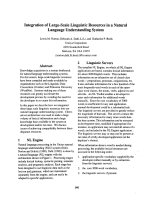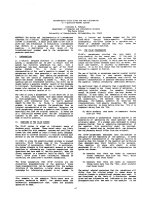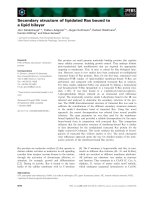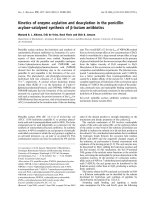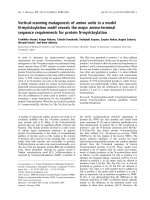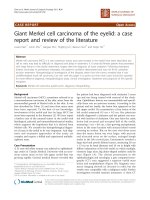Báo cáo khoa học: "Pearsonema (syn Capillaria) plica associated cystitis in a Fennoscandian arctic fox (Vulpes lagopus: a case report" pptx
Bạn đang xem bản rút gọn của tài liệu. Xem và tải ngay bản đầy đủ của tài liệu tại đây (2.7 MB, 4 trang )
Fernández-Aguilar et al. Acta Veterinaria Scandinavica 2010, 52:39
/>Open Access
BRIEF COMMUNICATION
© 2010 Fernández-Aguilar et al; licensee BioMed Central Ltd. This is an Open Access article distributed under the terms of the Creative
Commons Attribution License ( which permits unrestricted use, distribution, and repro-
duction in any medium, provided the original work is properly cited.
Brief communication
Pearsonema (syn Capillaria) plica
associated cystitis
in a Fennoscandian arctic fox (
Vulpes lagopus
: a
case report
Xavier Fernández-Aguilar
1
, Roland Mattsson
1
, Tomas Meijer
2
, Eva Osterman-Lind
3
and Dolores Gavier-Widén*
1,4
Abstract
The bladderworm Pearsonema (syn Capillaria) plica affects domestic dogs and wild carnivores worldwide. A high
prevalence in red foxes (Vulpes vulpes) has been reported in many European countries. P. plica inhabits the lower urinary
tract and is considered to be of low pathogenic significance in dogs mostly causing asymptomatic infections. However,
a higher level of pathogenicity has been reported in foxes. A severe cystitis associated with numerous bladderworms
was found in a captive arctic fox (Vulpes lagopus) originating from the endangered Fennoscandian arctic fox
population. To our knowledge this is the first description of P. plica infection in an arctic fox.
Background
The arctic fox (Vulpes lagopus; syn. Alopex lagopus)
inhabiting the mountain tundra of Fennoscandia (Nor-
way, Sweden and Finland) is regionally threatened to
extinction [1]. The main threats today are inter-specific
competition with red foxes (Vulpes vulpes) and low food
availability in certain periods due to the lemming (Lem-
mus lemmus) cycle [2]. In addition, a small population
size in combination with a fragmented structure may
convey negative effects related to the smallness itself [3].
As part of the conservation efforts, a breeding-in-captiv-
ity program was initiated in 1992 at a Swedish breeding
center for endangered species ("The Nordic Ark"). The
program produced offspring but the foxes were affected
by a neurological disease which resulted in the termina-
tion of the breeding colony [4]. The foxes of the colony
were closely monitored for diseases and thorough post-
mortem investigations were conducted on the animals
that succumbed. The necropsy in one of the arctic foxes
revealed numerous worms in the urinary bladder identi-
fied as Pearsonema plica. A severe cystitis was associated
with the presence of the parasites.
Pearsonema plica (Syn. Capillaria plica) belongs to the
superfamily Trichuroidea and inhabits the urinary blad-
der of the host. The ureters and the renal pelvis are how-
ever rarely affected. The infection has been described in
domestic dogs and wild carnivore mammals worldwide
and occurs frequently in some species [5-8]. The preva-
lence varies according to hosts, geographic region and
season. Several studies have revealed a high prevalence in
red foxes in many European countries [8-10].
P. plic a has an indirect life cycle. The eggs are passed
out with the urine from the definitive host and are
ingested by earthworms. In the intestine of the earth-
worm, the eggs hatch and the first stage larvae move
through the intestinal wall to encyst in the adjacent con-
nective tissue. Once the earthworm is eaten by the defini-
tive host, the first stage larvae moult to the second stage
within the wall of the small intestine. It remains there
from day 8 to day 10 after invasion. Third stage larvae are
found in the urinary bladder on or about the 30
th
day of
infection and it is assumed that they migrate through the
blood vessels to the urinary bladder. The development to
the fourth stage larvae and adult worm takes place within
the bladder. The prepatent period is around 8 weeks.
Besides the young carnivores, adult carnivores are also
infected with no evidence of developing acquired immu-
nity. Nonetheless, the infection appears to be self-limiting
with a reduction of egg excretion until being undetectable
after around 2 1/2 months [11,12].
P. plica is considered to be of low pathogenic signifi-
cance and in most cases, the parasite establish only
asymptomatic infections [13-16]. Occasionally cystitis
* Correspondence:
1
Department of Pathology and Wildlife Diseases. National Veterinary Institute
(SVA), SE-751 89 Uppsala, Sweden
Full list of author information is available at the end of the article
Fernández-Aguilar et al. Acta Veterinaria Scandinavica 2010, 52:39
/>Page 2 of 4
and secondary bacterial infections occur. Such cases have
been described in domestic dogs showing dysuria, hema-
turia, pollakiuria, polydipsia and urinary incontinence
[12,17-19]. In farmed silver foxes [18,19] and in experi-
mentally infected red foxes [11] anorexia, dysuria,
delayed growth and abnormality in mating have been
reported.
To our knowledge, P. p l ic a has not been reported previ-
ously in the arctic fox. This study describes the presence
of P. p li c a and associated lesions in a young arctic fox and
the pathogenic potential of this parasite in wild carni-
vores is discussed.
Case presentation
The case of this study was a juvenile female arctic fox
born in captivity at The Nordic Ark in a litter of 4 cubs,
whose dam had been caught in the wild. The dam and the
four cubs showed dry cough and mild respiratory signs
about three months before developing neurological signs
due to necrotizing encephalitis as described previously in
arctic foxes [4]. The fox had been treated with B-vita-
mins, antimicrobial drugs and corticosteroids. No
improvement was observed and the fox was euthanized at
7 months of age. Another cub in the litter was euthanized
one month later.
Blood samples were obtained just before euthanasia for
serology, hematology and clinical chemistry. A post-mor-
tem examination was conducted and specimens of all
major organs were sampled for histopathology, fixed in
10% neutral buffered formalin, processed and embedded
in paraffin. Sections were cut at 5 μm and stained with
hematoxylin and eosin. Selected sections from the uri-
nary bladder and kidneys were also stained with Van
Gieson's stain for connective tissue and with periodic
acid-Schiff for glycogen and other carbohydrates. Intes-
tines, lung, muscle tissue and urinary bladder were exam-
ined for parasites by direct microscopy, the intestinal
contents by a sedimentation method, and muscle for
Trichinella spp by the digestion method. Serological anal-
yses were conducted for antibodies against Encephalito-
zoon cuniculi, Toxoplasma gondii, Neospora caninum,
distemper virus and contagious canine hepatitis. Samples
for virus isolation in A-72 cells included lungs, liver, kid-
ney, brain and spleen [4].
At post-mortem examination the fox was found in good
body condition and weighed 3.8 kg. Multiple areas of dif-
fuse haemorrhage on the surface of the kidneys and a
hyperemic mucosa in the urinary bladder were observed.
About 20 threadlike, 2-3 cm long nematodes were found
in the bladder. According to their morphology and local-
ization, the parasites were identified as P. plic a . Examina-
tion of faeces revealed the presence of eggs of Eucoleus
(syn Capillaria) spp. These were probably eggs of Euco-
leus (syn. Capillaria) aerophilus subsequently found his-
tologically in the lung and upper respiratory airways.
The histopathology of the urinary bladder showed a
severe sub-acute inflammation with infiltration of pre-
dominantly eosinophils with some plasma cells and lym-
phocytes in the mucosa extending into the inner
muscular layers (Figure 1). The urothelium showed intra-
epithelial infiltration of eosinophils, degeneration and
detachment. There was congestion of the mucosa and
small haemorrhages in areas subjacent to the epithelial
damage (Figure 2). There was apparent fibroplasia in
superficial parts of the lamina propria with a severe
inflammatory infiltrate. Sections of nematodes were pres-
ent in the lumen of the bladder adjacent to the surface
(Figure 3 & Figure 4). The rostral end of a worm was seen
embedded into the superficial mucosa. In the kidneys,
infiltration of few mononuclear cells and eosinophils in
the submucosa of the pelvis was seen. The lungs pre-
sented interstitial, eosinophilic pneumonia with granu-
lomatous reactions around Capillaria spp eggs. In the
trachea there was also a moderate eosinophilic infiltra-
tion comprising the mucosa and submucosa with exudate
and debris in the lumen. The fox also had a severe non-
suppurative meningoencephalitis as described in other
cases [4].
Blood parameters, hematocrit, urea, creatinine, aspar-
tate aminotranseferase (ASAT), creatine kinase (CK), ala-
nine aminotransferase (ALAT), alkaline phosphatase
(ALP) and albumin were within the normal range for dog.
Reference values for the arctic fox are not available. The
number of eosinophils was slightly increased (18% -
1,5×10
9
/L) as were lymphocyte numbers (38% - 3,2×10
9
/
L), while neutrophil numbers were diminished (36% -
Figure 1 Histopathology of the urinary bladder of an arctic fox
with Pearsonema plica infection. Severe inflammatory infiltration of
predominately eosinophils in the lamina propria and in superficial lay-
ers of the muscularis propria. Stain: hematoxylin and eosin.
Fernández-Aguilar et al. Acta Veterinaria Scandinavica 2010, 52:39
/>Page 3 of 4
3,1×10
9
/L). The total leukocyte count remained within
the normal range. The other analyses did not reveal
abnormalities or signs of infections.
To our knowledge, P. p li c a infection has not been
reported before in arctic foxes. For endangered species, it
is particularly important to identify and catalogue the
pathogens which may affect their survival thus allowing
monitoring and, when suitable, intervention. This is par-
ticularly true for hosts exposed to long periods of starva-
tion, concomitant parasitic and/or other infections and
environmental stress, such as it is often the case of the
Fennoscandian arctic fox in the wild. Even though the fox
of this study was not free-ranging and the source of infec-
tion remains unknown the finding of P. pli c a related cys-
titis demonstrates that this nematode may cause disease
in the arctic fox and therefore, this infection should be
included in the health monitoring of the endangered
Fennoscandian arctic fox. Moreover, studies that investi-
gated specifically the occurrence of P. p l ic a found a high
prevalence in red foxes in other regions of Europe and P.
plica seems to be a common parasite in this species [8-
10]. The inter-specific increasing competition between
arctic foxes and sympatric red foxes [2] may impact in the
parasites presence and dynamics in both populations,
including the possible prevalence of P. plic a in free rang-
ing arctic foxes, and could be considered as a risk factor
for the endangered population.
Information about the pathogenicity of P. p l i c a varies.
Mostly based on studies in dogs, it seems commonly
accepted, that the parasite only causes subclinical infec-
tion and is of low pathogenic significance [13-16]. How-
ever, earlier studies reports a higher level of pathogenicity
in foxes [11]. Red foxes were observed suffering of
chronic cystitis with signs of anorexia, hematuria, dysuria
and delayed growth. Silver foxes showed severe cystitis
with red, thickened, swollen mucosa of the bladder and
abnormality in mating procedures [18,19]. In the case of
this study, clinical signs of cystitis were not observed, but
possibly they were masked by the more severe signs of
encephalitis. Regardless, signs of cystitis in wild animals
are often overlooked. Most authors consider that the cys-
titis related to P. p lic a is related to secondary bacterial
infections. In our case, the fox had received antibiotic
therapy and there was no histological indication of sec-
ondary infection. It appeared histologically that the para-
site itself was damaging the mucosa of the bladder.
Eosinophilic inflammation was also observed in the renal
Figure 2 Histopathology of the urinary bladder of an arctic fox
with Pearsonema plica infection. Dense infiltrate of eosinophils in
the lamina propria, degeneration and detachment of urothelium and
microhaemorrhages. Stain: hematoxylin and eosin.
Figure 3 Sections of Pearsonema plica in the urinary bladder of an
arctic fox. Sections of the parasite embedded in the wall of the blad-
der. Stain: hematoxylin and eosin.
Figure 4 Sections of Pearsonema plica in the urinary bladder of an
arctic fox. The rostral end and the body of the parasite are embedded
in the wall of the bladder. Stain: hematoxylin and eosin.
Fernández-Aguilar et al. Acta Veterinaria Scandinavica 2010, 52:39
/>Page 4 of 4
pelvis. These observations agree with a previous report,
which describes severe damage to the urinary tract [12].
The findings in this case indicates that at least under spe-
cial circumstances, such as in animals with concomitant
diseases or subjected to corticosteroids treatment, the
pathogenicity of P. pli c a may be higher than generally rec-
ognized.
Besides the case in the fox described here, another juve-
nile arctic fox from the same litter, which had a similar
clinical history and was euthanized at the age of 8
months, also had severe sub-acute eosinophilic inflam-
mation of the urinary system with damage of the urinary
bladder mucosa. The renal pelvis showed more severe
and extensive infiltrate of eosinophils than the present
case. However, the presence of P. p l ic a could not be con-
firmed in this latter fox as parasitological investigation of
the bladder was not conducted. Even though infestations
of this parasite are usually self-limiting, treatment of cap-
tive arctic foxes with clinical disease may be necessary. A
single subcutaneous dose of ivermectin (0.2 mg/kg) has
been reported to be effective in domestic dogs and cats
[20,21] and might also be effective in foxes. Routine post-
mortem examination of wild animals does not usually
include examination with magnification or scrapping of
the urinary mucosa to detect parasite eggs or adult para-
sites. The adult P. p l i c a is thin, threadlike, and barely visi-
ble and therefore difficult to detect unless performing
microscopy. In addition, infected animals do not usually
show gross lesions in the urinary tract [12]. These factors
may contribute to under-reporting the prevalence of P.
plica infection in wild carnivores.
Conclusion
To our knowledge, P. pli c a infection has not been
described in arctic foxes. Little is known regarding patho-
gens in the endangered population of Fennoscandian arc-
tic foxes. The findings of a cystitis related to P. p l i c a
suggests that in certain cases this nematode may have
higher potential pathogenicity in the arctic fox than that
generally described in dogs. This is in agreement with
early descriptions of P. p lic a infection in foxes
Competing interests
The authors declare that they have no competing interests.
Authors' contributions
XFA carried out the pathology investigations, reviewed the literature and
drafted the manuscript. EO-L reviewed and discussed the parasitology. RM
contributed collecting the data, interpreting the findings and revising the
manuscript. TM provided the information on the biology and status of the arc-
tic foxes and revised the manuscript. DG-W coordinated the work of the study,
contributed to the pathology investigation and reviewed the manuscript. All
authors read and approved the final manuscript.
Acknowledgements
The study was financed by the EU project SEFALO +, LIFE03 NAT/S/000073. The
authors are grateful to Dr Kristina Nilsson and Dr Sune Gregorius for the clinical
observations and providing the material. We also thank the necropsy and his-
topathology technicians at SVA.
Author Details
1
Department of Pathology and Wildlife Diseases. National Veterinary Institute
(SVA), SE-751 89 Uppsala, Sweden,
2
Department of Zoology, Stockholm
University, 106 91 Stockholm, Sweden,
3
Department of Virology,
Immunobiology and Parasitology. National Veterinary Institute (SVA), SE-751 89
Uppsala, Sweden and
4
Department of Biomedical Sciences and Veterinary
Public Health, University of Agricultural Sciences (SLU), SE-751 89 Uppsala,
Sweden
References
1. Angerbjörn A, Hersteinsson P, Tannerfeldt M: Arctic fox (Alopex lagopus).
Canids: Foxes, Wolves, Jackals and Dogs - Status survey and
conservation action plan. IUCN Gland 2004:117-123.
2. Tannerfeldt M, Elmhagen B, Angerbjörn A: Exclusion by interference
competition? The relationship between red and arctic foxes. Oecologia
2002, 132:213-220.
3. Caughley G: Directions in conservation biology. J Anim Ecol 1994,
63:215-244.
4. Berg AL, Gavier-Widén D, Nilsson K, Widén F, Berg M, Gregorius S, Ågren E,
Erlandsson M, Mörner T: Necrotizing encephalitis of unknown cause in
Fennoscandian arctic foxes (Alopex lagopus). J Vet Diagn Invest 2007,
19:113-117.
5. Moravec F: Proposal of a new systematic arrangement of nematodes of
the family Capillariidae. Folia Parasitol (Praha) 1982, 29:119-132.
6. Butterworth EW, Burton MB: The Taxonomy of Capillaria spp.
(Nematoda:Trichuroidea) in Carnivorous Mammals from Ontario,
Canada. Syst Parasitol 1980, 1(3/4):211-236.
7. Segovia JM, Torres J, Miquel J, Llarenza L, Feliu C: Helminths in the wolf,
Canis lupus, from the north-western Spain. J Helminthol 2001,
75:183-192.
8. Davidson RK, Gjerde B, Turid V, Lillehaug A, Handeland K: Prevalence of
Trichinella larvae and extra-intestinal nematodes in Norwegian red
foxes (Vulpes vulpes). Vet Parasitol 2006, 136:307-316.
9. Sréter T, Széll Z, Marucci G, Poxio E, Varga I: Extraintestinal nematode
infections of red foxes (Vulpes vulpes) in Hungary. Vet Parasitol 2003,
115:329-334.
10. Saeed I, Maddox-Hyttel C, Monrad J, Kapel CMO: Helminths of red foxes
(Vulpes vulpes) in Denmark. Vet Parasitol 2006, 139:168-179.
11. Engik K: The biology of Capillaria plica (Trichuroidea, Nematodes) [in
German]. Zeitschr Tropenmed Parasitol 1950, 1:560-571.
12. Senior DF, Somon GB, Goldschmidt MH, Joyce T, Bovee KC: Capillaria
plica infection in dogs. J Am Vet Med Assoc 1980, 176:901-905.
13. Soulsby EJL: Helminths, Arthropods and Protozoa of Domestic Animals 7th
edition. London: Baillière Tindall; 1982:339-340.
14. Urquhart GM, Armour J, Duncan JL, Dunn AM, Jennings FW: Veterinary
Helminthology. In Veterinary Parasitology 2nd edition. Oxford: Blackwell
Science Ltd; 1996:96-97.
15. Kassai T: Veterinary Helminthology Oxford: Butterworth-Heinemann; 1999.
16. Taylor MA, Coop RL, Wal RL: Parasites of dogs and cats. In Veterinary
Parasitology 3rd edition. Oxford: Blackwell Publishing Ltd; 2007:429-430.
17. Meadway W, Skelley JF: Capillaria plica infection in a dog. J Am Vet Med
Assoc 1961, 139:907-908.
18. Volkmar F: Capillariasis vesico-urethralis of silver foxes. Vet Med 1930,
25:518-520.
19. Watkins CV, Harvey LA: On the parasites of silver foxes on some farms in
the SouthWest. Parasitol 1942, 34:155-179.
20. Bédard C, Desnovers M, Lavallée MC, Poirier D: Capillaria in the bladder of
an adult cat. Can Vet J 2002, 43:973-974.
21. Kirkpatrick CE, Nelson GR: Ivermectin treatment of urinary capillariasis in
a dog. J Am Vet Med Ass 1987, 191:701-702.
doi: 10.1186/1751-0147-52-39
Cite this article as: Fernández-Aguilar et al., Pearsonema (syn Capillaria) plica
associated cystitis in a Fennoscandian arctic fox (Vulpes lagopus: a case
report Acta Veterinaria Scandinavica 2010, 52:39
Received: 19 March 2010 Accepted: 12 June 2010
Published: 12 June 2010
This article is available from: 2010 Fernández-Aguilar et al; licensee BioMed Central Ltd. This is an Open Access article distributed under the terms of the Creative Commons Attribution License ( which permits unrestricted use, distribution, and reproduction in any medium, provided the original work is properly cited.Acta Veteri naria Scandina vica 2010, 52:39
